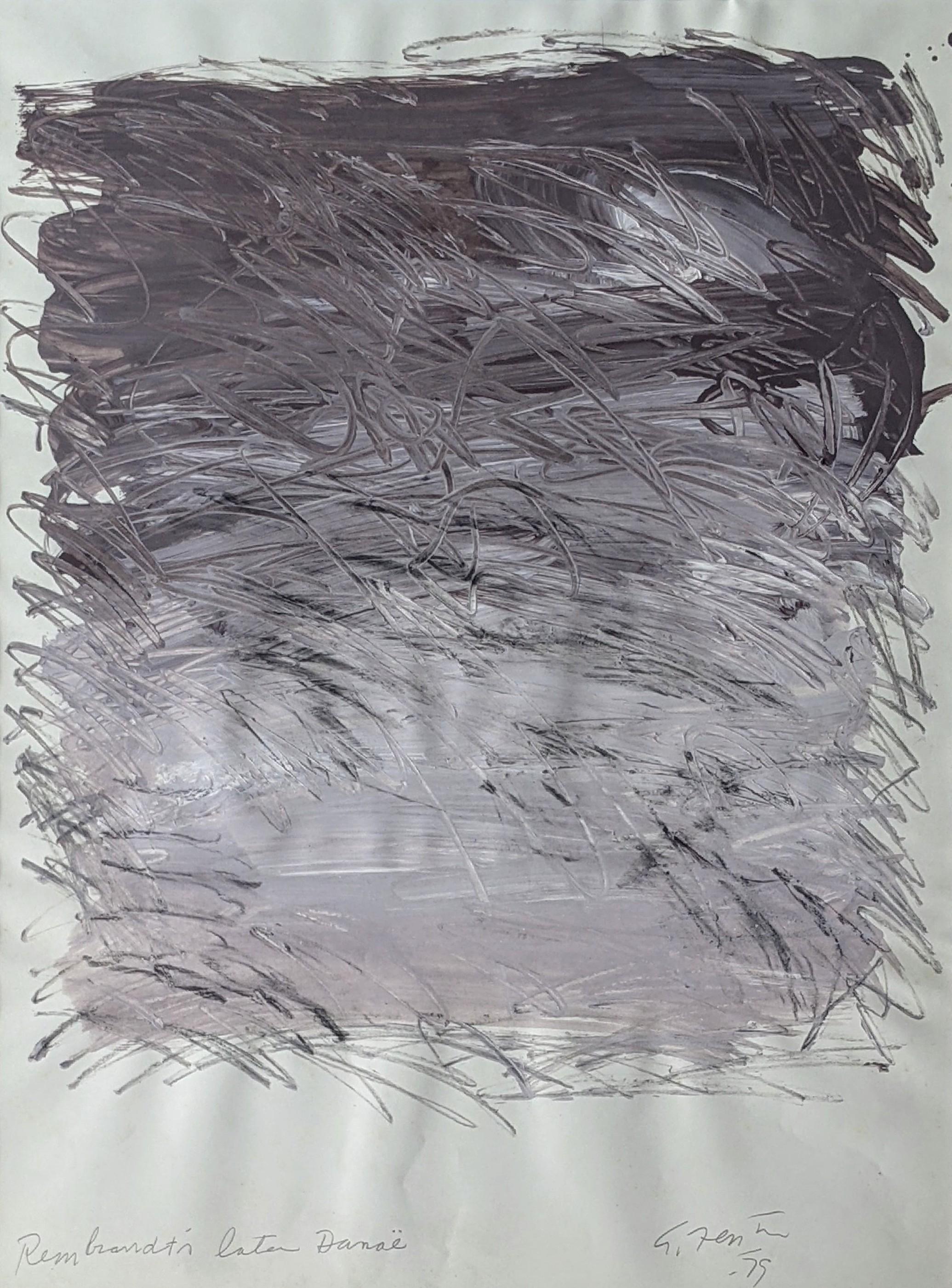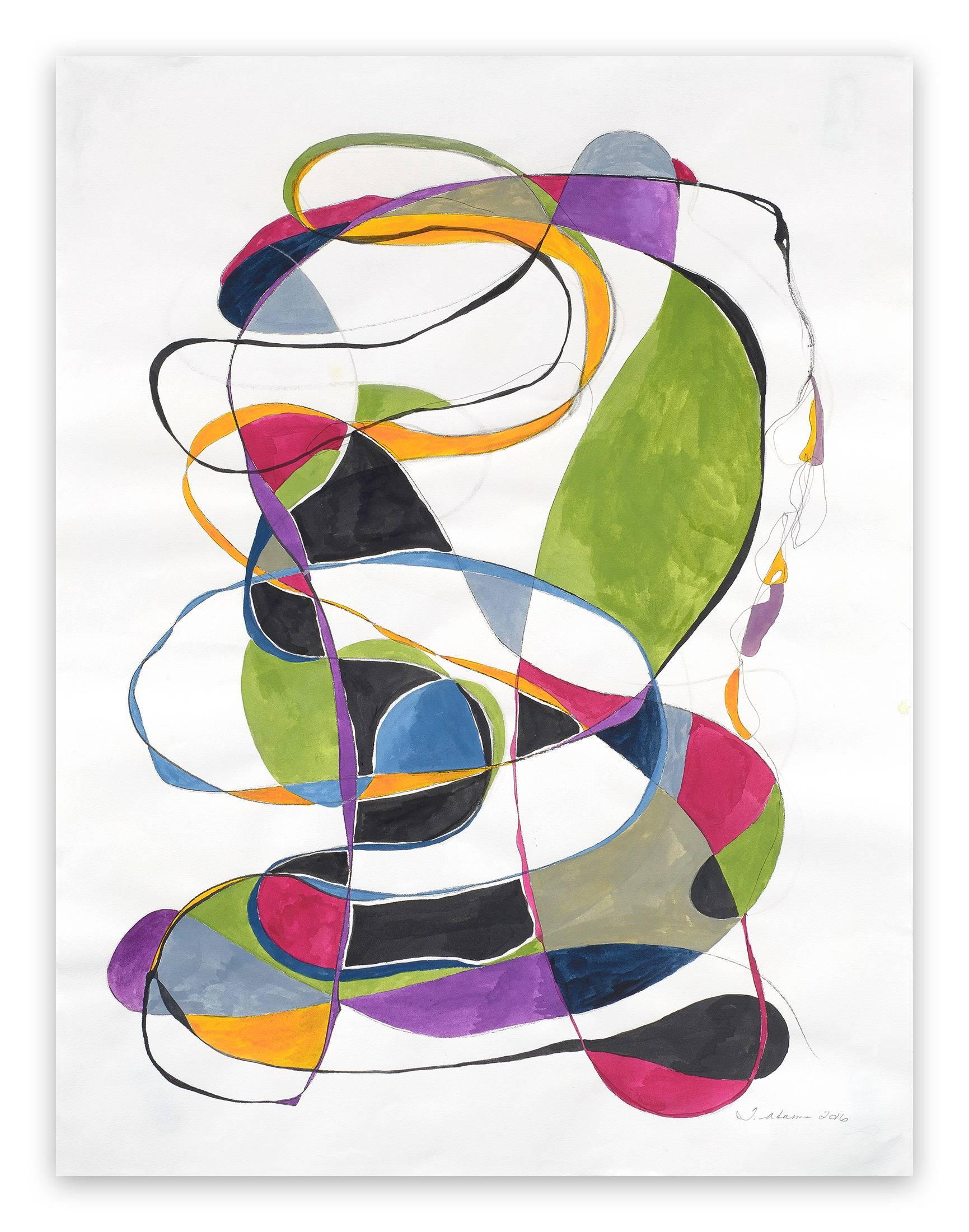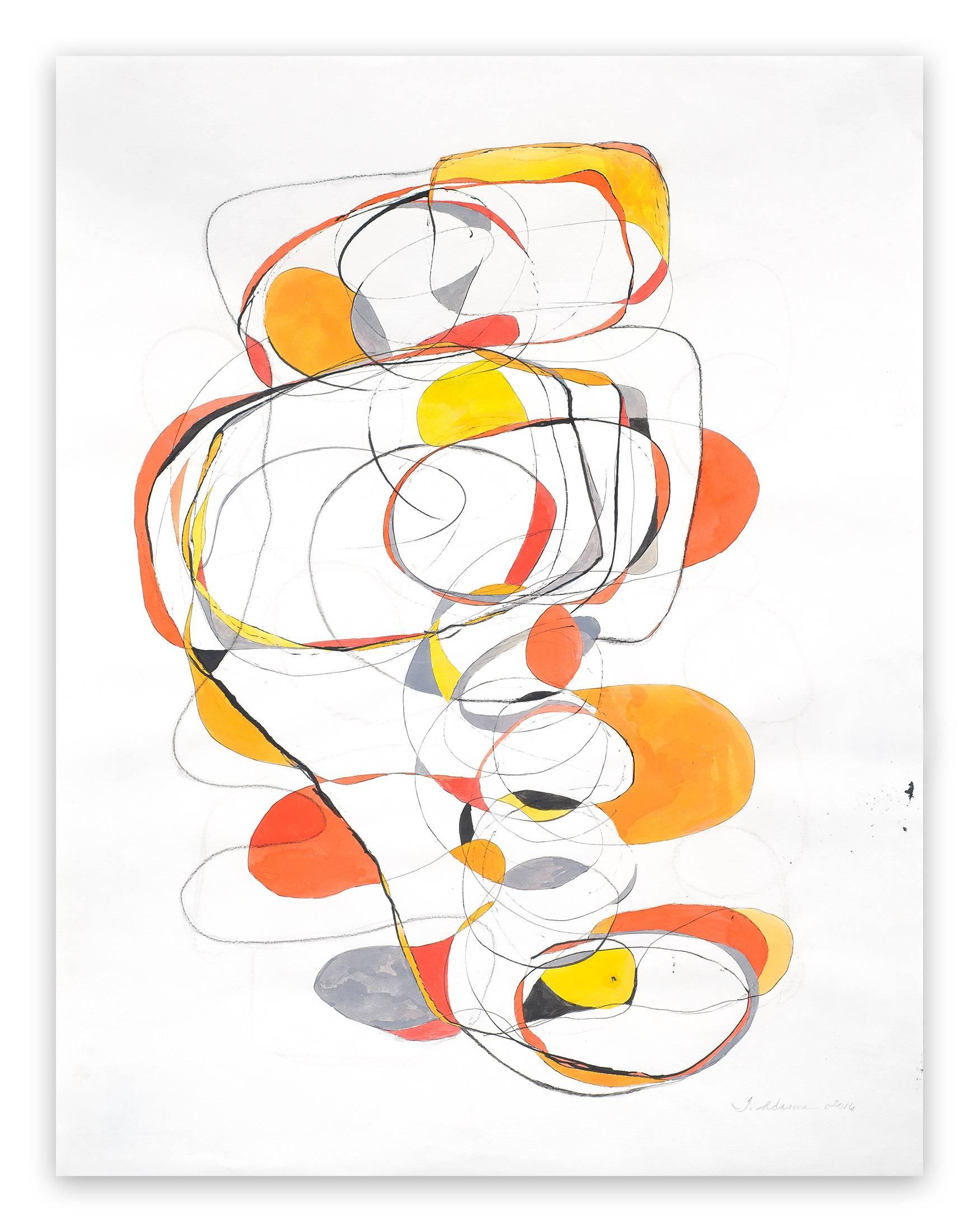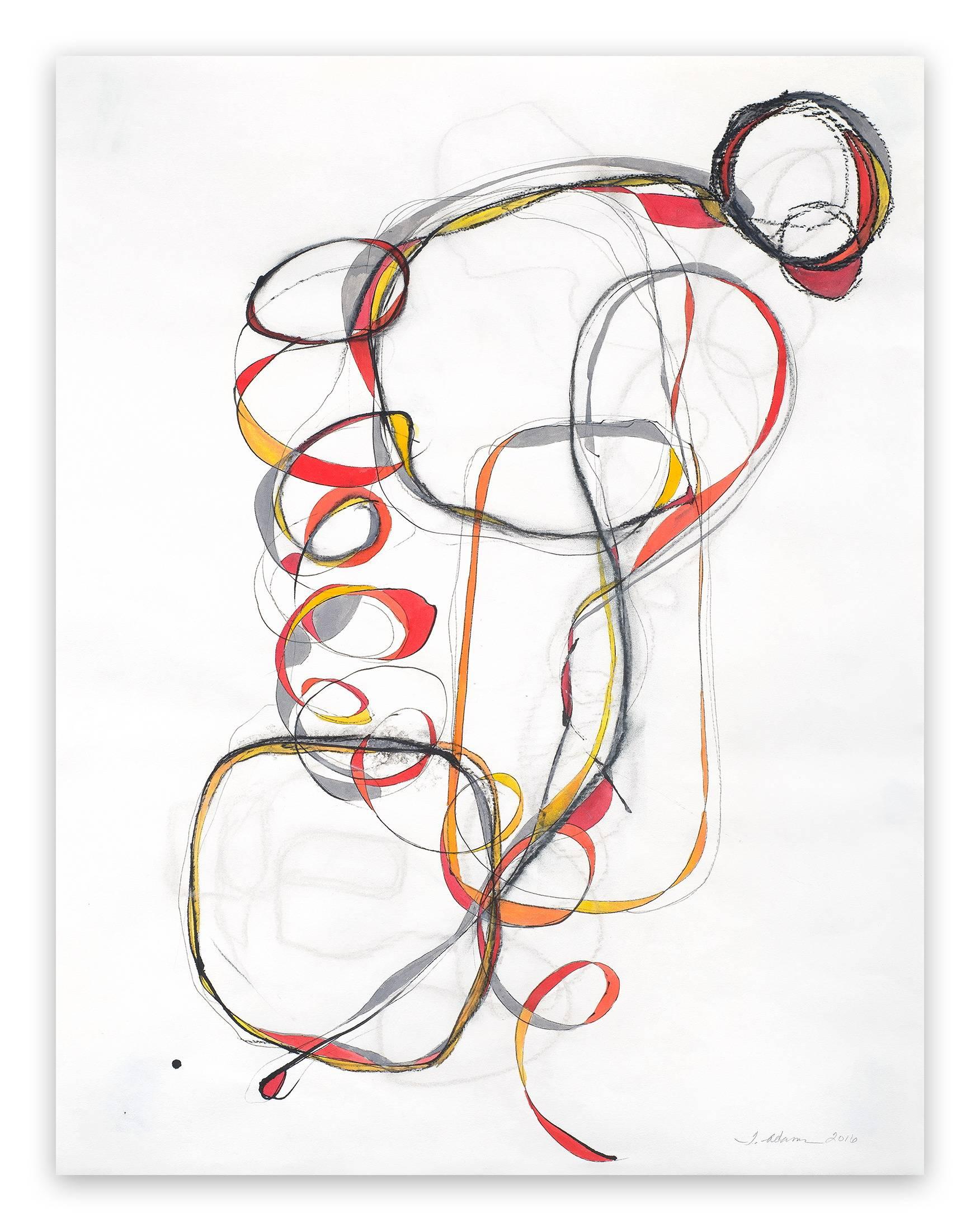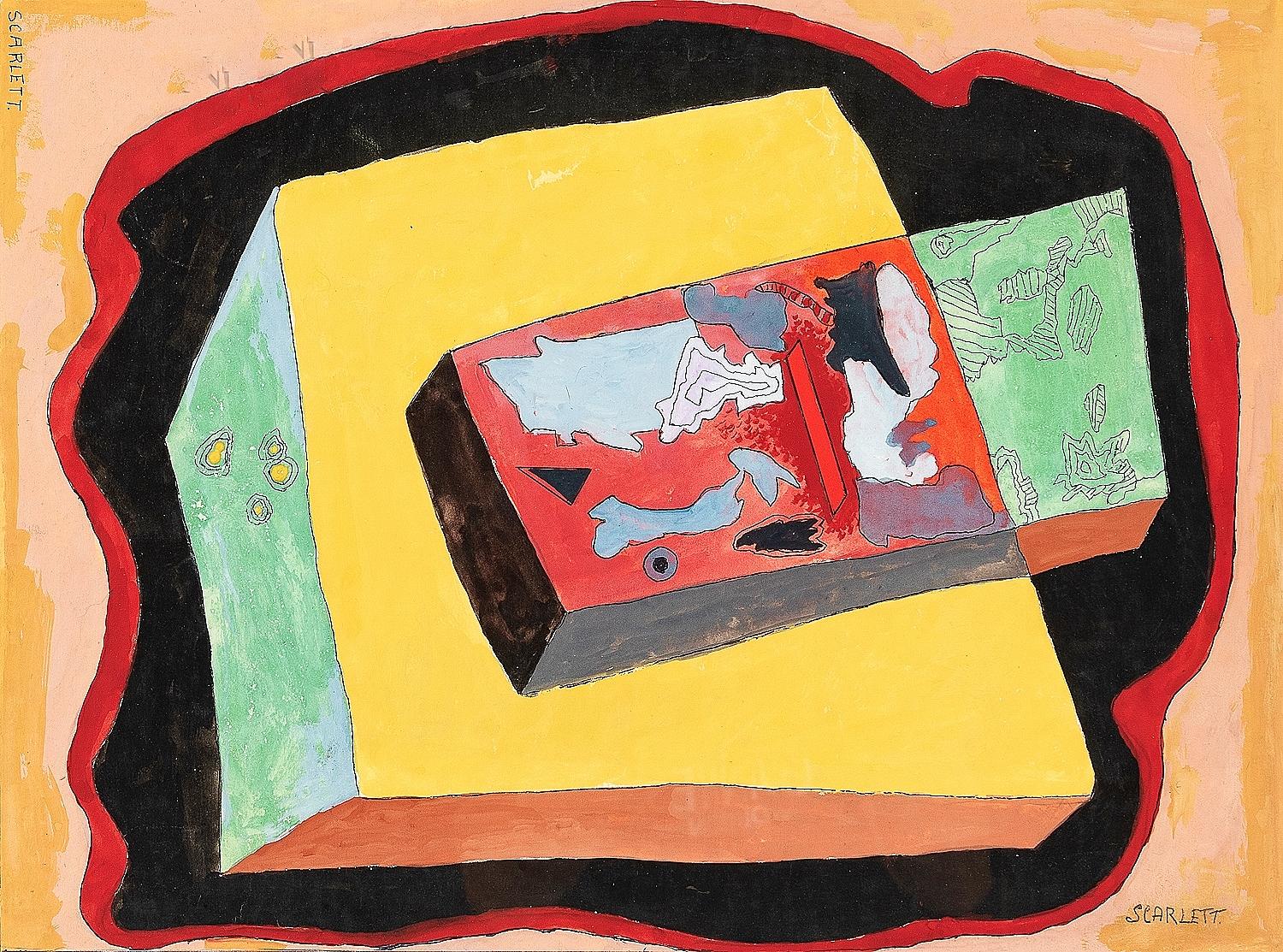Items Similar to Irene Rice Pereira Modernist Gouache Drawing Painting Abstract Expressionist Art
Want more images or videos?
Request additional images or videos from the seller
1 of 12
Irene Rice PereiraIrene Rice Pereira Modernist Gouache Drawing Painting Abstract Expressionist Art
About the Item
Irene Rice Pereira,
Mixed Media on Paper (American, 1902-1971)
Titled "The East Wind Carries the Seed"
Hand signed l.r. "I. Rice Pereira".
Paper: 14.1/8"h x 18.25"w
Irene Rice Pereira (1902 – 1971) was an American abstract artist, poet and philosopher who played a major role in the development of modernism in the United States. She is known for her work in the genres of geometric abstraction, abstract expressionism and lyrical abstraction, as well as her use of the principles of the Bauhaus school. Her paintings and writings were significantly influenced by the complex intellectual currents of the 20th century.
Pereira was born Irene Rice in Chelsea, Massachusetts, a suburb of Boston, the eldest of three sisters and one brother. Her sister Juanita Rice Guccione was also a painter. During her career, she often gave her year of birth as 1907, which appears on some legal documents. She spent her childhood in Great Barrington, Massachusetts, where she spent time reading and writing poetry.
After her father died in 1918 she and her family moved to Brooklyn, New York. In 1922 she began working as a stenographer in an accountant's office to help support her family in the wake of her father's death. She briefly attended courses in fashion design at the Traphagen School of Fashion and night courses in literature at New York University, and began taking evening art classes at Manhattan's Washington Irving High School. She immersed herself in the bohemian world of Greenwich Village and had a brief affair with the poet and novelist Maxwell Bodenheim.
In 1927, she enrolled in night art classes at the Art Students League in New York City. Among her instructors at the Art Students League were Jan Matulka and Richard Lahey. In her 1929 class Matulka provided Pereira with her first exposure to the artistic principles of the European avant-garde that would shape her work; most notably those of the Bauhaus, Cubism, and Constructivism. Here, Pereira was exposed to the work of Pablo Picasso and Henri Matisse as well as the Cubists and Constructivists. and was encouraged to experiment with Cubist abstraction. In 1931, she traveled to Europe and North Africa to further her painting studies, attending sessions at the Académie Moderne and studying with Amédée Ozenfant in Paris. She also spent time in Switzerland and Italy.
After returning to New York in 1933 she studied briefly with Hans Hofmann at the Art Students League. Her friends and colleagues were Burgoyne Diller, Dorothy Dehner, David Smith, Hilla Rebay, Arshile Gorky, John D. Graham, and Frederick Kiesler.
In 1935, Irene Pereira helped found the Design Laboratory, a cooperative school of industrial design established under the auspices of the WPA Works Progress Administration. The curriculum of the Design Laboratory was similar to that of the Bauhaus. All students were required to take a basic course that included an introduction to chemistry, physics, and art materials. Students experimented with materials in laboratories in order to understand their physical properties. There was an emphasis on social considerations, and students were taught the social implications of technological developments alongside classes in art, music, and literature. Pereira taught classes in painting, composition, and design synthesis.
Pereira painted throughout her life. Her paintings first gained recognition in the early 1930s, when she exhibited at the ACA Galleries and the Whitney Museum of American Art in New York. With the showcase at the Whitney, she became one of the first women (along with Loren MacIver and Georgia O'Keeffe) to be given a retrospective at a major New York museum. In the late 1930s, she started to move away from figurative, realistic work toward abstraction and experimented with painting on layered glass. In 1943, Pereira was included in Peggy Guggenheim's show Exhibition by 31 Women at the Art of This Century gallery in New York Artists included:
Leonora Carrington, Perle Fine, Leonor Fini, Buffie Johnson, Frida Kahlo, Lee Krasner, Louise Nevelson, Irene Rice Pereira, Dorothea Tanning and Charmion von Wiegand. In 1946, Pereira was included in the Museum of Modern Art's exhibition 1946: Fourteen Americans along with Arshile Gorky, David Hare, Isamu Noguchi, Robert Motherwell and Theodore Roszak.
During the latter part of her career, Pereira rejected abstract expressionist art and experienced difficulties with gallery owners and museum directors. She believed that art and literature were being swallowed up in "a chaotic void of mindlessness." Eventually, she left New York permanently and moved to Spain.
She created "machine paintings" that incorporated images of technological components, including ship's ventilators, generators, and funnels, as well as hinges, levers, and gears. Boat Composite from 1932, in the collection of the Whitney Museum of American Art is an example of her "machine paintings".
Pereira began to explore abstraction in the late 1930s and her work included fewer references to machines. She became known for the geometric and rectilinear paintings created during this period. Abstraction from 1940, in the collection of the Honolulu Museum of Art, demonstrates her approach to geometric abstraction. She was interested in finding a way to bring light into her work, and began to incorporate materials such as glass, plastic, gold leaf, and other reflective materials into her paintings. She experimented with radium paint, layers of painted glass, and paint on parchment.
In a 1950 statement, she said "My philosophy is the reality of light and space; an ever flowing--never-ceasing--continuity, unfettered by man made machinery, weight and external likenesses. I use geometric symbols because they represent structural essences and contain infinite possibilities of change and dynamics."
Pereira signed her work as "I. Rice Pereira," which caused many people to assume that she was a man.
Irene Rice Pereira's first husband was the commercial artist Humberto Pereira, a painter, whom she married in 1929. They divorced in 1938 and in 1941, she married George Wellington Brown, a naval architect who shared her interest in applying new materials to art. When this marriage ended in divorce, she married the Irish poet George Reavey in 1950; that marriage, too, ended in divorce in 1959.
Pereira worked prolifically as a writer, but she never received the same acclaim in this area as she did in painting. She published her first article in 1944, titled An Abstract Painter on Abstract Art. Her writings included topics such as structure, time, optics, and space.
The Boca Raton Museum of Art, the Brooklyn Museum, the Hirshhorn Museum and Sculpture Garden, the Honolulu Museum of Art, the National Gallery of Art (Washington D.C.), The Phillips Collection (Washington D.C.), the Smithsonian American Art Museum, the University of Iowa Museum of Art, the Baltimore Museum of Art (Baltimore, Maryland), the Metropolitan Museum of Art (New York City), the Addison Gallery of American Art (Andover, Massachusetts), the Museum of Modern Art (New York City), the Dallas Museum of Art (Dallas, Texas), the Munson-Williams-Proctor Institute (Utica, New York), the Frances Lehman Loeb Art Center (Poughkeepsie, New York), the Whitney Museum of American Art (New York City), and the Philadelphia Museum of Art (Philadelphia, Pennsylvania) are among the public collections holding work by I. Rice Pereira.
- Creator:Irene Rice Pereira (1902-1971, American)
- Dimensions:Height: 14.13 in (35.9 cm)Width: 18.25 in (46.36 cm)
- Medium:
- Movement & Style:
- Period:
- Condition:
- Gallery Location:Surfside, FL
- Reference Number:1stDibs: LU38214309652
About the Seller
4.9
Platinum Seller
These expertly vetted sellers are 1stDibs' most experienced sellers and are rated highest by our customers.
Established in 1995
1stDibs seller since 2014
1,549 sales on 1stDibs
Typical response time: 1 hour
- ShippingRetrieving quote...Ships From: Surfside, FL
- Return PolicyA return for this item may be initiated within 3 days of delivery.
More From This SellerView All
- Mod Abstract Expressionist W/C Painting Bernard Segal New Hope PA Modernist ArtLocated in Surfside, FLFramed 19 x 26. Image 14 X 21 Bernard Segal was born in Cincinnati, Ohio and attended Cincinnati University and the Cincinnati Art Academy. He was known for figure, abstract painting, collage, and cartoon illustration. In the 1920's and 30's, he lived in NYC and attended The Art Students League where he was creative with a number of artistic styles of the period. During WWII, he worked as a cartoonist for a government issued newspaper called 10-SHUN that was published in Greensboro, NC. Bernard worked under the pen name Seeg, and was the author of the comic strip "Hank and Honey," that appeared in the New York Herald Tribune from the 1940's through the 50's. This cartoon was syndicated and published in Quebec under the title "Louise et Louis." The strip was later retitled to Ellsworth. Segal also illustrated a number of Jewish books that were published by the Union of American Hebrew Congregations, and Bible stories. In the 1950's Segal moved to Bucks County, Pennsylvania, and became a member of the New Hope Modernists. He worked with esteemed artists such as George Nakashima, Charles Evans, Louis Stone, Lloyd ney, josef Zenk, Clarence Carter and Charles Ramsey. Segal's most noted work was made during the 1960's, during which time he produced paintings and collages in the abstract expressionist style. He enjoyed painting bright abstract oil...Category
1960s Abstract Expressionist Abstract Paintings
MaterialsPaper, Watercolor
- Modernist Abstract Expressionist Watercolor Painting Bauhaus Weimar ArtistBy Pawel KontnyLocated in Surfside, FLAbstract watercolor composition bearing the influence of the earlier color-block compositions of Paul Klee and Abstract Expressionist master Sam Francis. Pawel August Kontny, (Polish-German-American artist) He was born in Laurahuette, Poland, in 1923, the son of a wealthy pastry shop owner. In 1939 he began studying architecture in Breslau where he was introduced to the European masters and to the work of some of the German Expressionists, soon afterward banned as "degenerate artists" and removed from museums throughout Germany by the Nazi regime. His studies were interrupted by World War II. Drafted into the German army, traveling in many countries as a soldier, he sketched various landscapes but in 1945, he was captured and held as a prisoner of war in Italy. After the war, he studied at the Union of Nuremberg Architects to help design buildings to replace ones destroyed in the war. He recorded his impressions of the local population and the landscapes through his watercolors and drawings. Pawel Kontny thereafter moved to Nuremberg, Germany, becoming a member of the Union of Nuremberg Architects and helping to rebuild the city's historic center. He soon decided to concentrate on his professional art career. He married Irmgard Laurer, a dancer with the Nuremberg Opera. Pavel Kontny 's career as an artist was launched with his participation in an all German exhibition, held at the Dusseldorf Museum in 1952. He held one-man shows in Germany, Switzerland and the United States. During his trip to the United States in 1960, Kontny became instantly enamored with Colorado, and decided to relocate to Cherry Hills with his wife and two children. He quickly established himself in the local art community, being affiliated for a time with Denver Art Galleries and Saks Galleries. His subject matter became the Southwest. During this time he received the Prestigious Gold Medal of the Art Academy of Rome. His extensive travel provided material for the paintings he did using his hallmark marble dust technique. he also worked equally in pastel, watercolor, charcoal and pencil-and-ink. in a style which merged abstraction and realist styles, influenced by Abstract Expressionist painting and South Western American landscapes. In the early 1960s he was one of only a few European-born professional artists in the state, a select group that included Herbert Bayer (1900-1985), a member of the prewar Bauhaus in Weimar and Dessau, Germany, and Roland Detre (1903-2001), a Hungarian modernist painter. As a Denver, Colorado resident, Pavel Kontny exhibited at galleries and museums throughout the United States, Germany and Japan. There, he was inspired by frequent trips to Native American pueblos in the Southwest, as well as by the study of the Plains Indians of Montana and Wyoming. Over the years Kontny had a number of students and generously helped young artist by hosting exhibitions at his Cherry Hills home. For many years he generously donated his paintings to support charitable causes in Denver. Influences during his European years included German pastelist C.O. Muller, German Informel painter Karl Dahmen and Swiss artist, Hans Erni. In the early 1950s his painting style showed the influence of the Die Brücke (The Bridge), a group of German expressionist artists formed in Dresden in 1905 who had a major impact on the evolution of modern art in the twentieth century in Germany. By the middle of the decade his style incorporated more referential abstraction and total abstraction, resulting in part from his study of Hans Hartung, a German artist based in Paris who exhibited his gestural abstract work in Germany. The American moon landing in 1969 inspired Paul Kontny...Category
20th Century Abstract Expressionist Abstract Drawings and Watercolors
MaterialsWatercolor, Archival Paper
- Modernist Abstract Expressionist Watercolor Painting Bauhaus Weimar Pawel KontnyBy Pawel KontnyLocated in Surfside, FLAbstract watercolor composition bearing the influence of the earlier color-block compositions of Paul Klee. Pawel August Kontny, (Polish-German-American artist) He was born in Laurahuette, Poland, in 1923, the son of a wealthy pastry shop owner. In 1939 he began studying architecture in Breslau where he was introduced to the European masters and to the work of some of the German Expressionists, soon afterward banned as "degenerate artists" and removed from museums throughout Germany by the Nazi regime. His studies were interrupted by World War II. Drafted into the German army, traveling in many countries as a soldier, he sketched various landscapes but in 1945, he was captured and held as a prisoner of war in Italy. After the war, he studied at the Union of Nuremberg Architects to help design buildings to replace ones destroyed in the war. He recorded his impressions of the local population and the landscapes through his watercolors and drawings. Pawel Kontny thereafter moved to Nuremberg, Germany, becoming a member of the Union of Nuremberg Architects and helping to rebuild the city's historic center. He soon decided to concentrate on his professional art career. He married Irmgard Laurer, a dancer with the Nuremberg Opera. Pavel Kontny 's career as an artist was launched with his participation in an all German exhibition, held at the Dusseldorf Museum in 1952. He held one-man shows in Germany, Switzerland and the United States. During his trip to the United States in 1960, Kontny became instantly enamored with Colorado, and decided to relocate to Cherry Hills with his wife and two children. He quickly established himself in the local art community, being affiliated for a time with Denver Art Galleries and Saks Galleries. His subject matter became the Southwest. During this time he received the Prestigious Gold Medal of the Art Academy of Rome. His extensive travel provided material for the paintings he did using his hallmark marble dust technique. he also worked equally in pastel, watercolor, charcoal and pencil-and-ink. in a style which merged abstraction and realist styles, influenced by Abstract Expressionist painting and South Western American landscapes. This one is influenced by California Abstract Expressionist artist Sam Francis. In the early 1960s he was one of only a few European-born professional artists in the state, a select group that included Herbert Bayer (1900-1985), a member of the prewar Bauhaus in Weimar and Dessau, Germany, and Roland Detre (1903-2001), a Hungarian modernist painter. As a Denver, Colorado resident, Pavel Kontny exhibited at galleries and museums throughout the United States, Germany and Japan. There, he was inspired by frequent trips to Native American pueblos in the Southwest, as well as by the study of the Plains Indians of Montana and Wyoming. Over the years Kontny had a number of students and generously helped young artist by hosting exhibitions at his Cherry Hills home. For many years he generously donated his paintings to support charitable causes in Denver. Influences during his European years included German pastelist C.O. Muller, German Informel painter Karl Dahmen and Swiss artist, Hans Erni. In the early 1950s his painting style showed the influence of the Die Brücke (The Bridge), a group of German expressionist artists formed in Dresden in 1905 who had a major impact on the evolution of modern art in the twentieth century in Germany. By the middle of the decade his style incorporated more referential abstraction and total abstraction, resulting in part from his study of Hans Hartung, a German artist based in Paris who exhibited his gestural abstract work in Germany. The American moon landing in 1969 inspired Paul Kontny...Category
20th Century Abstract Expressionist Abstract Drawings and Watercolors
MaterialsWatercolor, Archival Paper
- Large Colorful Modernist Pastel Abstract Expressionist Painting Sylvia CareweLocated in Surfside, FLFramed 33 X 45.5 image is 29 X 41.5 Hand signed lower left Signed and titled verso Sylvia Carewe (1906-1981) was an American woman artist, painter, writer and poet. Born in New York City to Russian immigrant parents, Louis and Esther Kerewsky, she changed her surname to "Carewe" in 1930. Carewe attended Columbia University and studied further with Yasuo Kuniyoshi at Atelier 17 in New York, with Hans Hoffman in New York and Provincetown, Massachusetts, and at the New School for Social Research. During World War II Carewe worked as an advertising copywriter and artist for agencies in New York. She became a prolific abstract artist in a range of media, including tapestry designs for the Aubusson tapestry carpet company in France, felt banners, collage reliefs, and what she termed "blown paintings," which were assemblages (predominantly of children's toy components) overlaid with spray paint. One of the most common subjects in her semi abstract paintings was New York City at night. She also worked in traditional artistic media, including watercolors, oils, lithographs and pastels. In October 1944, she married Marvin Small (formerly Smalheiser, executive for Carter's Little Liver Pills). They had one child, John Marvin, in June 1947. Carewe had her first one-woman show in Poughkeepsie in 1947, after which she opened in New York City at the ACA Gallery in 1948. She had some twenty other American solo shows and her works hung in many exhibits across the United States as well as in France, Belgium and the Netherlands. Her works are represented in the permanent collections of the Whitney Museum, Musée de l'Arte Moderne, Paris, Brandeis University, the Butler Art Institute, Howard University, the Tel Aviv Museum and the National Museum in Djakarta, Indonesia. Her work has been described by French critics as "violent, colorful art, in hard contrasts, not exempt from cold lyricism." ["Les Girls...Category
Mid-20th Century Abstract Expressionist Abstract Paintings
MaterialsOil Pastel, Paper
- Large 80s Vibrant Dynamic Drawing/Painting Memphis Milano EraBy Peter StevensLocated in Surfside, FLit is currently unframed and will be sold thus. Similar in style to the 80s work of Elizabeth Murray. A bright, colorful expressive piece signed (labels are not included as it is un...Category
1980s 85 New Wave Abstract Drawings and Watercolors
MaterialsConté, Charcoal, Gouache, Rag Paper, Graphite
- Post Soviet Nonconformist Avant Garde Russian Israeli Gouache Painting GrobmanBy Michail GrobmanLocated in Surfside, FLMIchail Grobman Gouache and watercolor on paper Hand signed Lower Left and Dated 1964. Described inn Cyrillic Russian verso. Dimensions: L:13.25" W: 11.75". Michail Grobman (Russian: Михаил Гробман, Hebrew: מיכאיל גרובמן, born 1939) is an artist and a poet working in Israel and Russia. He is father to Hollywood producer Lati Grobman and Israeli architect Yasha Jacob Grobman. Biography 1939 – Born in Moscow. 1960s – Active member of The Second Russian Avant-Garde movement in the Soviet Union. 1967 – Member of Moscow Artists Union. 1971 – Emigrates to Israel and settles in Jerusalem. 1975 – Founded the Leviathan group and art periodical (in Russian). Since 1983, he lives and works mainly in Tel Aviv. Awards In 2001, Grobman was a co-recipient of the Dizengoff Prize for Painting. Solo exhibitions 2007 – Last Skies, Loushy & Peter Art & Projects, Tel Aviv (cat. text: Marc Scheps) 2006 – Creation From Chaos to Cosmos, Bar-David Museum of Fine Art and Judaica, Kibbutz Baram (cat. text: Sorin Heller) 2002 – The Last Sky, installation, Tsveta Zuzoritch pavilion, Belgrad (cat. text: Irina Subotitch) 1999 – Mikhail Grobman: Works 1960–1998, The State Russian Museum, St. Petersburg (cat. texts: Evgeniya Petrova, Marc Scheps, Lola Kantor-Kazovsky, Michail German) Michail Grobman was born in Moscow. He grew up writing poetry, essays and literary prose. In the 1960s, he was active in the Second Russian Avant-garde movement in the Soviet Union. In 1971, he immigrated to Israel. In 1975, he established the Leviathan school together with Avraham Ofek and Shmuel Ackerman, seeking to combine symbolism, metaphysics and Judaism in an all-inclusive “national style.” Grobman’s lithograph work employs images and symbols from Jewish mysticism and Kabbalah. His paintings incorporate texts in Russian and Hebrew. In addition to his artistic endeavors, he writes about art and aesthetics. The group combined conceptual art and "land art" with Jewish symbolism. Of the three of them Avraham Ofek had the deepest interest in sculpture and its relationship to religious symbolism and images. In one series of his works Ofek used mirrors to project Hebrew letters, words with religious or cabbalistic significance, and other images onto soil or man-made structures. In his work "Letters of Light" (1979), for example, the letters were projected onto people and fabrics and the soil of the Judean Desert. In another work Ofek screened the words "America", "Africa", and "Green card" on the walls of the Tel Hai courtyard during a symposium on sculpture Part of the generation of emigre Russian artists, many Jewish, that included Yuri Kuper, Komar and Melamid, Eduard Steinberg, Erik Bulatov, Viktor Pivovarov, Vladimir Yankilevsky, Ilya Kabakov and Grisha Bruskin. Date of Birth: 1939, Moscow 1960s Active member of The Second Russian Avant Garde 1967 Member of the Moscow Painters Association 1971 Immigrated to Israel and settled in Jerusalem 1975 Founded the Leviathan group and art periodical (in Russian) Since 1983 Lives and works in Tel Aviv . Selected Solo Exhibitions: 2002 Pavilion Zveta Zuzovich, "The Last Sky", Belgrad (cat: Irena Subotitch) 1999 The State Russian Museum, ST. Petersburg 1998 "Picture = Symbol + Concept", Herzliya Museum of Art, Herzliya 1995 "Password and Image", University Gallery, Haifa University 1990 Tova Osman Gallery, Tel Aviv 1989 "The Beautiful Sixties in Moscow", The Genia Schreiber University Art Gallery, Tel Aviv University (with llya Kabakov; cat. text: Mordechai Omer] Spertus Museum, Chicago Beit Rami and Uri Nechushtan, Ashdot Yaacov (leaflet) 1972 Nora Gallery, Jerusalem 1973 - Negev Museum, Beer Sheva 1971 Tel Aviv Museum of Art (cat. text: Haim Gamzu) 1966 Mos-lng-Projekt, Moscow 1965 Artist's House, Moscow Energy Institute, Moscow History Institute, Moscow Usti-nad-Orlicy Theatre,Czechoslovakia (leaflet text: Dushan Konetchni) 1959 Mukhina Art Institute, Leningrad . Selected Group Exhibitions: 2003 "Yes do yourself...", Regeneration of Judaism in Israeli art, Zman Omanut Tel Aviv (cat: Gideon Ofrat) 1999 "Russian post-war avantgarde", The Trajsman Collection in the State Russian Museum, St. Petersburg Tretjakov National Gallery, Moscow (cat. text: Yevgenij Barabanov, John Bolt...Category
1960s Modern Abstract Paintings
MaterialsPaper, Watercolor, Gouache
You May Also Like
- "Rembrandt Later Danae, " Alan Fenton, Abstract ExpressionismLocated in New York, NYAlan Fenton (1927 - 2000) Rembrandt Later Danae, 1975 Watercolor on paper 23 x 17 inches Signed and dated lower right; titled lower left Fenton's quiet an...Category
1970s Abstract Expressionist Abstract Paintings
MaterialsGouache, Paper, Watercolor
- Balancing act 4By Tracey AdamsLocated in London, GBGouache, graphite and ink on Rives paper. Unframed. Balancing Act 4 is part of a series of works on paper started in 2016. They are created in the evenings and aptly named after busy days of teaching and other responsibilities. The artist establishes parameters involving the use of a particular palette, certain mark-making gestures and amount of time spent on each drawing. This work incorporates graphite, ink, and gouache, and is a combination of intuition-based and planned execution. Tracey Adams is an American abstract painter and printmaker. Her artworks reflect a strong interest in musical patterns, rhythms, lyrical compositional elements and what she calls a sense of performance. She lives and works in Carmel, California. Work by Adams is part of the permanent collections of several museums, including the Bakersfield Art Museum, the Monterey Museum of Art, the Fresno Art Museum, the Tucson Art...Category
2010s Abstract Expressionist Abstract Paintings
MaterialsPaper, Ink, Gouache, Graphite
- Balancing act 2 (Abstract Painting)By Tracey AdamsLocated in London, GBBalancing act 2 (Abstract Painting) Gouache, graphite and ink on Rives paper. Unframed. Balancing Act 2 is part of a series of works on paper started in 2016. They are created in the evenings and aptly named after busy days of teaching and other responsibilities. The artist establishes parameters involving the use of a particular palette, certain mark-making gestures and amount of time spent on each drawing. This work incorporates graphite, ink, and gouache, and is a combination of intuition-based and planned execution. Tracey Adams is an American abstract painter and printmaker. Her artworks reflect a strong interest in musical patterns, rhythms, lyrical compositional elements and what she calls a sense of performance. She lives and works in Carmel, California. Work by Adams is part of the permanent collections of several museums, including the Bakersfield Art Museum, the Monterey Museum of Art, the Fresno Art Museum, the Tucson Art...Category
2010s Abstract Expressionist Abstract Paintings
MaterialsPaper, Ink, Gouache, Graphite
- Balancing act 4 (Abstract Painting)By Tracey AdamsLocated in London, GBBalancing act 4 (Abstract Painting) Gouache, graphite and ink on Rives paper. Unframed. Balancing Act 4 is part of a series of works on paper started in 2016. They are created in the evenings and aptly named after busy days of teaching and other responsibilities. The artist establishes parameters involving the use of a particular palette, certain mark-making gestures and amount of time spent on each drawing. This work incorporates graphite, ink, and gouache, and is a combination of intuition-based and planned execution. Tracey Adams is an American abstract painter and printmaker. Her artworks reflect a strong interest in musical patterns, rhythms, lyrical compositional elements and what she calls a sense of performance. She lives and works in Carmel, California. Work by Adams is part of the permanent collections of several museums, including the Bakersfield Art Museum, the Monterey Museum of Art, the Fresno Art Museum, the Tucson Art...Category
2010s Abstract Expressionist Abstract Paintings
MaterialsPaper, Ink, Gouache, Graphite
- Balancing Act 3 (Abstract Painting)By Tracey AdamsLocated in London, GBBalancing Act 3 (Abstract Painting) Gouache, graphite and ink on Rives paper. Unframed. Balancing Act 3 is part of a series of works on paper started in 2016. They are created in the evenings and aptly named after busy days of teaching and other responsibilities. The artist establishes parameters involving the use of a particular palette, certain mark-making gestures and amount of time spent on each drawing. This work incorporates graphite, ink, and gouache, and is a combination of intuition-based and planned execution. Tracey Adams is an American abstract painter and printmaker. Her artworks reflect a strong interest in musical patterns, rhythms, lyrical compositional elements and what she calls a sense of performance. She lives and works in Carmel, California. Work by Adams is part of the permanent collections of several museums, including the Bakersfield Art Museum, the Monterey Museum of Art, the Fresno Art Museum, the Tucson Art...Category
2010s Abstract Expressionist Abstract Paintings
MaterialsPaper, Ink, Gouache, Graphite
- Abstract in Three DimensionsBy Rolph ScarlettLocated in Lawrence, NYGouache on paper Jo Aarons Gallery Label en verso Never afraid of trying new styles, curious and opinionated, constantly engaged with the world around him, Rolph Scarlett more than ...Category
1940s Abstract Expressionist Abstract Drawings and Watercolors
MaterialsGouache
